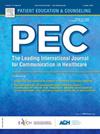Questions older people and caregivers ask about kidney therapies: A computer-assisted analysis
IF 2.9
2区 医学
Q2 PUBLIC, ENVIRONMENTAL & OCCUPATIONAL HEALTH
引用次数: 0
Abstract
Background
Older adults with advanced chronic kidney disease (CKD) face complex and often overwhelming decisions regarding kidney therapy (KT), yet little is known about the specific information they and their caregivers seek during these discussions. Understanding informational needs is critical for improving shared decision-making.
Objectives
To identify and compare questions asked by patients and caregivers during KT decision-making visits.
Methods
A dataset of 36 transcribed kidney therapy (KT) decision-making focused outpatient palliative care encounters—conducted by a single clinician in patient homes and/or a single clinic—was analyzed using computational linguistic techniques supplemented by manual verification. Participants included 25 patients aged ≥ 75 years with an estimated glomerular filtration rate ≤ 25 ml/min/1.73 m², identified by nephrologists as needing KT decision-making support. Caregivers (n = 15) were included when present. All patients received a decision aid and question prompt list. Visits were led by a nephrologist board-certified in palliative care.
Results
Across 36 visits, 640 questions were recorded, averaging 17.78 per visit. The presence of a caregiver did not significantly affect the number of questions patients asked (10.42 vs. 10.00). Patients were more likely to ask conversational cooperation questions (37 % vs. caregivers' 19 %), while caregivers focused more on dialysis (38 % vs. patients' 25 %). Both groups asked a similar amount of questions about chronic kidney disease (patients 11 %, caregivers 10 %) and conservative kidney management (patients 4 %, caregivers 5 %). End-of-life inquiries were minimal, with patients asking 4 % of questions and caregivers none.
Conclusions
Patients and caregivers have different information needs during KT decision-making, highlighting the importance of addressing educational, decisional, and EOL planning gaps.
Practice Implications
Targeted educational interventions that address patients' and caregivers' unique preferences and information gaps are essential, including question prompt lists and decision aids with coaching, which AI-driven approaches could further optimize.
老年人和护理人员询问肾脏治疗的问题:计算机辅助分析
背景:患有晚期慢性肾脏疾病(CKD)的老年人在肾脏治疗(KT)方面面临复杂且往往压倒性的决定,但他们和他们的护理人员在这些讨论中寻求的具体信息知之甚少。了解信息需求对于改善共同决策至关重要。目的识别和比较患者和护理人员在KT决策访问中提出的问题。方法采用计算语言技术,辅以人工验证,分析了36个转录肾治疗(KT)决策重点门诊姑息治疗的数据集,这些数据集由单个临床医生在患者家中和/或单个诊所进行。参与者包括25名年龄≥ 75岁的患者,肾小球滤过率≤ 25 ml/min/1.73 m²,经肾病学家确定需要KT决策支持。护理人员(n = 15)也包括在内。所有患者均获得决策辅助和问题提示列表。就诊由一名在姑息治疗方面获得认证的肾病专家带领。结果在36次访问中,记录了640个问题,平均每次访问17.78个。护理人员的存在对患者提出的问题数量没有显著影响(10.42 vs 10.00)。患者更有可能提出对话合作问题(37% % vs.护理人员19 %),而护理人员更关注透析(38% % vs.患者25 %)。两组对慢性肾脏疾病(患者11 %,护理人员10 %)和保守肾脏管理(患者4 %,护理人员5 %)提出了类似数量的问题。临终问询极少,患者问询的比例为4%( %),而照护者一个问题也没有。结论患者和护理人员在KT决策过程中存在不同的信息需求,突出了解决教育、决策和EOL计划差距的重要性。实践意义解决患者和护理人员独特偏好和信息差距的有针对性的教育干预措施是必不可少的,包括问题提示列表和指导决策辅助,人工智能驱动的方法可以进一步优化。
本文章由计算机程序翻译,如有差异,请以英文原文为准。
求助全文
约1分钟内获得全文
求助全文
来源期刊

Patient Education and Counseling
医学-公共卫生、环境卫生与职业卫生
CiteScore
5.60
自引率
11.40%
发文量
384
审稿时长
46 days
期刊介绍:
Patient Education and Counseling is an interdisciplinary, international journal for patient education and health promotion researchers, managers and clinicians. The journal seeks to explore and elucidate the educational, counseling and communication models in health care. Its aim is to provide a forum for fundamental as well as applied research, and to promote the study of organizational issues involved with the delivery of patient education, counseling, health promotion services and training models in improving communication between providers and patients.
 求助内容:
求助内容: 应助结果提醒方式:
应助结果提醒方式:


